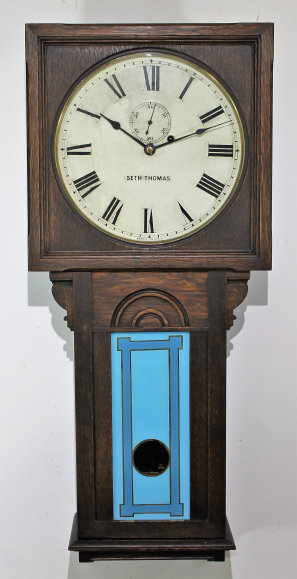

547. $525
Waterbury “Calendar No. 36”, ca. 1891. This is a small Waterbury calendar, only 28 inches in
a refinished oak case with knurled columns and ample carvings; the finish is old with a bit of crustiness. Both dials are painted,
probably original, with slight chipping to the calendar dial. The door glass is old. The 8-day time and half-hour strike
movement is running and the calendar is advancing. Good labels on the back. The movements are pictured on page 306 of
Ly’s book Calendar Clocks. We’ve only sold one in the last decade; there were three sales at RO Schmitt’s in the last five years
for $750-$800. $600-$800.
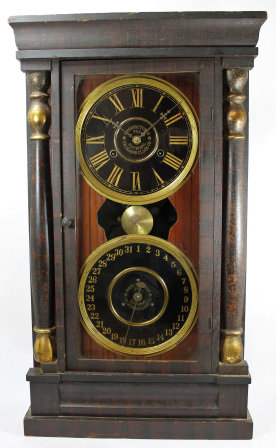
548. $250
National Calendar Clock Co. “Column Calendar”, ca. 1890. The movements were made by New Haven
Clock Co. and no location was ever given for NCCCo. Ly (Calendar Clocks) shows three models, but they also made a Fashion model. This one is all original, from the grain-painted “veneer” (hidden under decades of grime) to the faux marble columns and gilt capitals
and plinths. Both dials are original painted metal with some touch-up to the numbering; the hands are brass and just need some
polish. The New Haven signed movement is very dirty and hasn’t been run in years, but we’ve got it going; it strikes on a cathedral
gong and the simple calendar is advancing. These clocks never have a label. Note that the left cornice return is missing
its top and the right cornice return is also damaged, and the left column plinth is missing part of its base. It stands 27 inches
tall; if you want to put the time into cleaning the finish it will be the best-looking example of this model I have seen. These
typically sell for $500-$600 at major auction houses, and $450 and up on eBay. $450-$600.
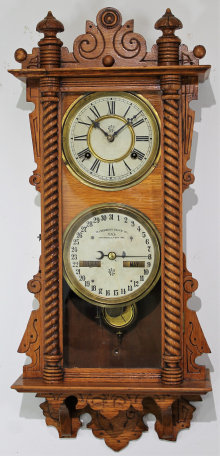
549. $850
E. Howard Clock Co. “No. 70 Wall Regulator”, ca.1920. A 31-inch oak case that looks like it
was made in the early 1900’s. It is marked “7” in several places, including the case, lower door, and pendulum stick. The dial door is marked “6”, suggesting that it is a replacement. The lower glass is rebacked or repainted on old glass, the
dial glass looks like a newer replacement. The 12-inch zinc dial looks to have been repainted, the hands are correct. The weight is marked “70”, the pinned movement is signed and has steel rather than brass plates. There is no label and the wood
weight shield has been replaced with a metal shield. It is running and keeping time. No. 70’s in oak have been bringing
$900-$1000 of late.
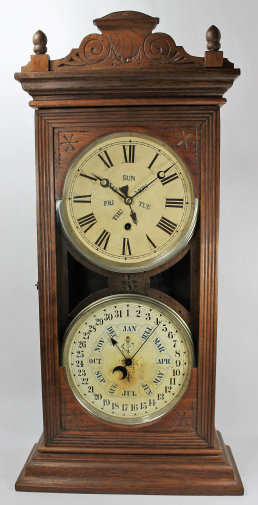
550. $500
Jerome & Co. “Register”, ca. 1880. This firm was owned by the New Haven Clock Co. which
marketed calendar clocks under this name. They used a BB Lewis calendar mechanism, note the label inside. There is also
a label on the back. The walnut case is just under 28 inches tall with a clean old finish. The door glass is old and likely
original; the lower dial is original, painted with black and blue lettering, while the time dial is a paper replacement. The
two small finials on top are replacements, not quite to specs. The 8-day time-only movement is running and the calendar is advancing. This clock is described and pictured in Ly’s Calendar Clocks on page 200. The most recent sale of a mantel Register on eBay
was in last May for $885. $600-$900.
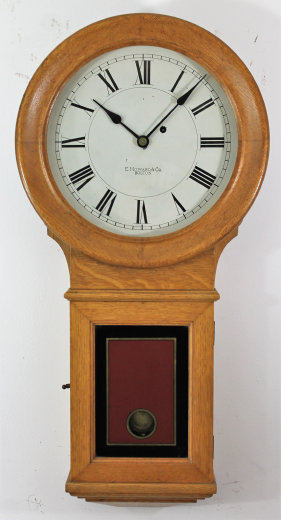
551. $950
Wm. Cummens banjo, ca. 1820. A Federal-style weight-driven banjo attributed to Wm Cummens
of Roxbury in a 33-inch banded-mahogany case. The signature on the very old painted iron dial has been added or strengthened,
so we can’t be sure it is by Cummens, but note the gold ring inside the numerals that is found on other Cummens banjos. He did
not sign his movements, which used a T-bridge as found here. Both glasses were repainted by Thomas Moberg on old glass, the
dial glass is newer. The hands are original, the weight old, the top finial a replacement. It is running easily and includes
a winder. $1200-$2500.

552. $500
Waltham “Banjo No. 31”, ca. 1905. A weight-driven banjo in a 40.5-inch mahogany case. Both reverse-painted images are original, with some losses to the background, mostly along the edges. The painted iron dial
reads “S. A. Mac Queen Co.”, a silver retailer in Philadelphia in the early 1900’s. There is a convex glass in the brass bezel
and two original iron hands. The signed movement runs 8 days; it is running without problem. The major drawback to this
large banjo is the replacement base – a well-carved piece that closely, but not exactly, matches the mahogany case. If you can
live with that you will have a nice banjo that otherwise typically sells for over $1000. $500-$800.
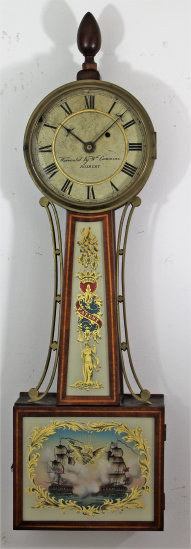
553. $300
E. Howard & Co. lever banjo, ca. 1920? This is a 30-inch banjo with an E. Howard-signed
lever spring movement. The dial is also signed. I can’t find another example for comparison. Both glasses are reverse-painted,
the dial glass is convex. It could use a bit of polish, but otherwise looks to be entirely original and complete. It is
running but looks to be a bit slow. There is a fast-slow adjustment and a key; no label. This is an ideal clock for you
if you live on a houseboat or yacht. $300-$500.
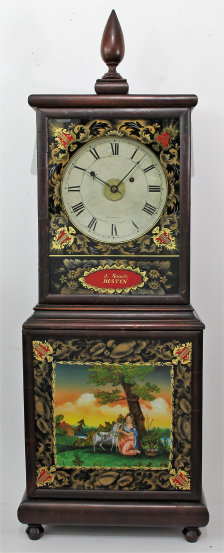
554. $2300
J Sawin Massachusetts shelf clock, ca. 1830. John Sawin apprenticed with Aaron Willard, Jr. and worked out of Boston until 1857; he is best known for his presentation banjos. This 38-inch mahogany-cased timepiece includes
an uncommon alarm that strikes on a bell above the movement, two old glasses repainted in period style, possibly the original top
finial, and four turned feet. The finish needs a bit of cleaning and polish and perhaps some staining touch-up due to wear on
the sides of the dial door. The dial door latches and opens from the right; the dial is iron, dish-shaped, with original paint
and signature. The short pendulum hangs behind the movement and behind the lead weight. I see no replaced pieces; note
the wooden pulley on the left side for the alarm lead weight. The lower tablet “girl with a goat” is really quite nice. The clock is running and keeping time and the alarm is working. This is the third of three uncommon early shelf clocks
we have been able to offer in the past year. We sold a David Wood ($7500) and a Nathan Munroe ($3500) in July. $2500-$5000.
Open Interior Interior-left Interior-right Back Left view Right view

555. $1500
Seth Thomas “Regulator No. 25”, 1913. This clock came in two sizes, a 32-inch model and a
37-inch model, the latter being associated with the Harvey Houses on the Santa Fe Railroad. This is the 37-inch model and is
stamped on the back “1913E”; although there were 84 Harvey Houses at one time, in 1901 there were 45, mostly along the Atchison, Topeka
& Santa Fe route. There is no label with this clock and no indication in which Harvey House restaurant it resided. The distinctive blue design on the lower glass has been rebacked or repainted, on old glass; the dial glass is also old. The
painted dial is old, but may have been repainted or touched up. The three hands are correct, the signed No. 2 movement is running
and keeping time. The weight is ST issue but the pendulum does not have a damascened bob. The oak case is called “Flemish
oak”. We sold a near-identical model in 2017 for $3250. $1500-$3000.
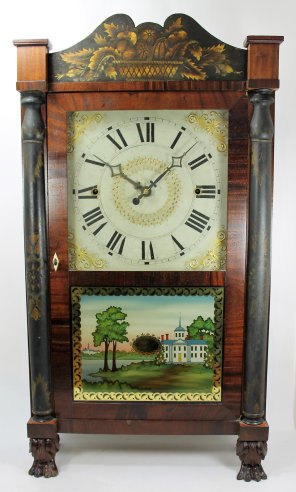
556. $550
Norris North column & splat shelf clock, 1824-1831. A 29-inch shelf clock with a Torrington
“east-west” 30-hour wooden movement. Everything but the tablet looks original; the tablet was repainted by Mr. Moberg, quite
nicely. The stenciling on the splat is strong but less so on the columns. The matching wood dial is in good shape with
some soiling, both glasses are old and reputtied into the door. There are two short stress fractures in the upper glass, but
they are stable. The hands are period, there is a good label inside, along with two iron weights, a pendulum bob, and a winding
key. The movement is running but the strike side is sticky. Note that the claw feet and turned feet in back appear to
be original; finding original rear feet is rare. The veneer is good all around; this is a nice example of a Torrington movement
fit into a standard-width period shelf clock. We sold this clock in 2012 for $550. $600-$900.
